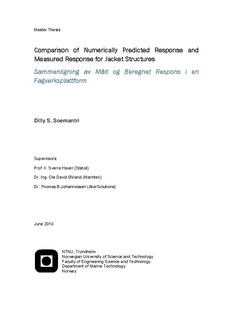| dc.contributor.author | Soemantri, Dilly Septiady | nb_NO |
| dc.date.accessioned | 2014-12-19T12:06:08Z | |
| dc.date.available | 2014-12-19T12:06:08Z | |
| dc.date.created | 2010-12-08 | nb_NO |
| dc.date.issued | 2010 | nb_NO |
| dc.identifier | 375426 | nb_NO |
| dc.identifier.uri | http://hdl.handle.net/11250/237825 | |
| dc.description.abstract | Previous studies on Kvitebjørn jacket have shown that there are discrepancies between the response obtained from numerical simulations and field measurement record. For some cases, numerical simulations under predict the response of the structure when measured wave elevation is used as input. The reason for these discrepancies is so far still in question.
In this study, the following efforts were done to asses other possibilities of discrepancy of the the response:
Modification of wave height.Impact assessment due to breaking waves.Observation on NORSOK N-003 recommended hydrodynamic coefficients.
The analyses include the following combinations of kinematics and surface properties:
Airy kinematics combined with second order surfaceWheeler stretching kinematics combined with second order surfaceSecond order kinematics combined with linear surface
The simulation is done by using the latest updated model developed by MARINTEK (Økland O. D., 2009). The simulation results have shown that the wave crest at platform location is under predicted approximately for 3m. One possible cause for this is the occurrence of pyramid-shaped wave.
The impact assessments in this study are using the wave impact model proposed by Wienke & Oumeraci and by Campbell & Weynberg. Simulations then show that impact profile as proposed by Wienke and Oumeraci may not be suitable for assessing the response. By using this impact profile, the response of the structure is still under predicted. The quasi-static response resulted from this impact profile seems to have under predicted the real response at the estimated impact time. The dynamic response is under predicted too even though the behavior can be modeled pretty well. Impact model as proposed by Campbell and Weynberg was able to approximate the measured response better than the previous impact profile in this case. Total response and dynamic response can be represented pretty well and if the presence of caissons/riser between the legs of the platform is considered, the quasi-static response may be able to be approximated well too.
For the case of slender drag dominated structure like Kvitebjørn, simulations show that a bigger drag coefficient than the one proposed by NORSOK N-003 should be used to approximate the impact load on the structure. | nb_NO |
| dc.language | eng | nb_NO |
| dc.publisher | Norges teknisk-naturvitenskapelige universitet, Fakultet for ingeniørvitenskap og teknologi, Institutt for marin teknikk | nb_NO |
| dc.title | Comparison of Numerically Predicted Response and Measured Response for Jacket Structures | nb_NO |
| dc.title.alternative | Sammenligning av Målt og Beregnet Respons i en Fagverksplattform | nb_NO |
| dc.type | Master thesis | nb_NO |
| dc.contributor.department | Norges teknisk-naturvitenskapelige universitet, Fakultet for ingeniørvitenskap og teknologi, Institutt for marin teknikk | nb_NO |
